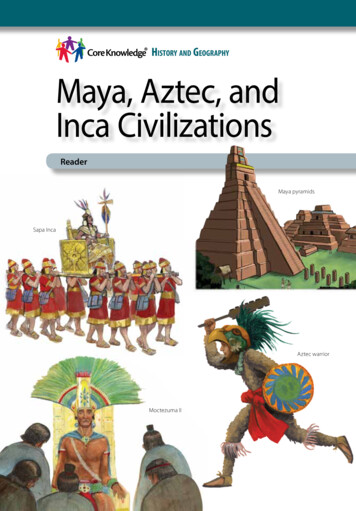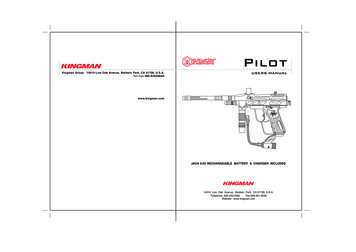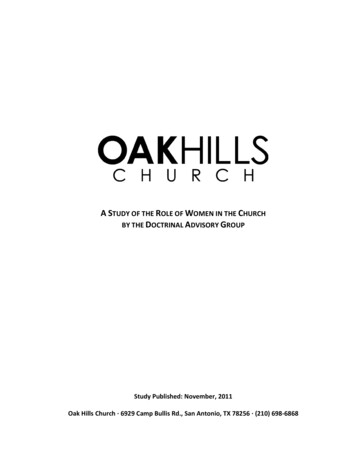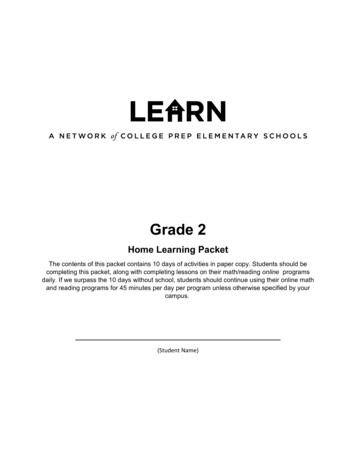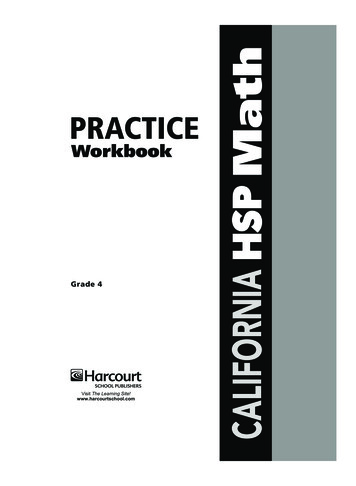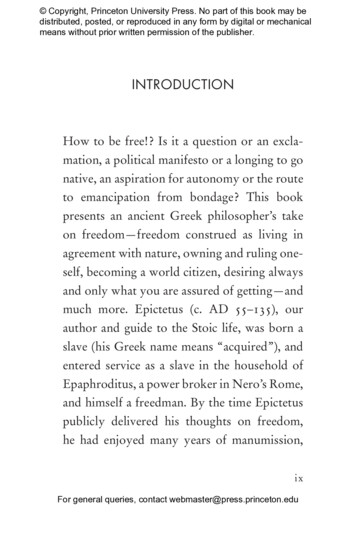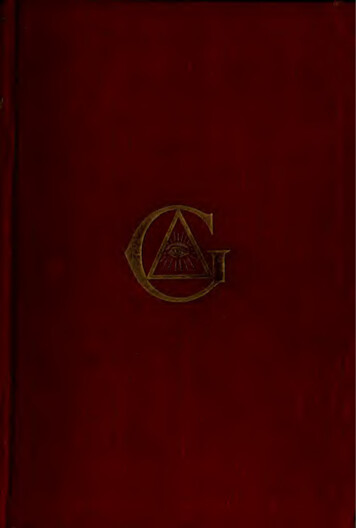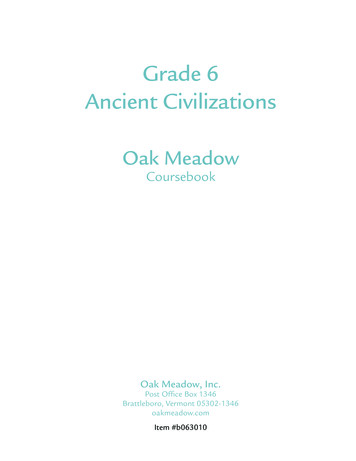
Transcription
Grade 6Ancient CivilizationsOak MeadowCoursebookOak Meadow, Inc.Post Office Box 1346Brattleboro, Vermont 05302-1346oakmeadow.comItem #b063010
Grade6ContentsIntroductionFor the Student. viiCourse Materials and Organization. viiiFor the Parent. ixAssessment Measures in Home Learning.xInformation for Students Enrolled inOak Meadow School. xiLessonsLesson 1: Stone Age. 1Early humans; tools and survival; prehistoric artLesson 2: Ancient Mesopotamia. 11Sumerian culture; early writing; Hammurabi’s Code; Hanging Gardensof BabylonLesson 3: Ancient Egypt. 21Early Egyptian cultures; pharaohs; early methods of measuring time;research reportLesson 4: Ancient Egyptian Civilization. 33Early Egyptian writing; Hatshepsut; research reportLesson 5: Ancient Israelites. 41Old Testament stories; migration of ancient Hebrews; Moses;compare and contrastiii
ContentsGrade 6 Ancient CivilizationsLesson 6: Hebrew History. 47The twelve Hebrew tribes; King Solomon; proverbsLesson 7: Ancient Persia. 57Cyrus the Great; King Darius I; Zoroaster; paper marblingLesson 8: Ancient India. 67Indian religions; Buddhist Eight-Fold Path; Indian music; research reportLesson 9: Ancient China. 83Chinese dynasties; traditional family life; role of females; comparingtraditional and modern valuesLesson 10: Chinese Philosophy and Inventions. 91Confucius; Lao-Tzu; Chinese inventionsLesson 11: Ancient Africa. 97Pygmies; Nubia and Kush; Sundiata of Mali; Anansi stories; Africandrumming and artsLesson 12: Ancient Crete. 117Minoan culture; palace at Knossos; Theseus and the Minotaur;creating a labyrinthLesson 13: Ancient Greece. 125Mycenaean; democracy; Greek architecture; Seven Wonders of theWorld; battle of TroyLesson 14: Ancient Greek Civilization. 143Spartan life; Alexander the Great; Greek arts and entertainment;sports and competitive gamesLesson 15: Ancient Rome. 155The fall of the Roman Republic; Justinian Law; Hannibalcrossing the Alps; rhetoric.Lesson 16: The Roman Empire. 173Gods and goddesses; poets; community life; Mt. Vesuviusand Pompeii; the fall of the Roman EmpireivOak Meadow
Grade 6 Ancient CivilizationsContentsLesson 17: Christianity. 185The early life of Jesus; Christian teachings and philosophy;the spread of ChristianityLesson 18: Islam. 195The early life of Mohammad; Islamic teachings and philosophy;the Five Pillars of Islam; the spread of IslamLesson 19: Barbarians and Celts. 207Early Germanic tribes; ancient Celtic gods; early art and architectureLesson 20: Middle Ages. 217Influence of the Catholic Church; Vikings; arts of the Middle AgesLesson 21: Knights and Nobles of the Middle Ages.233Feudal system; castle defenses and castle life; Norman conquestLesson 22: England and France in the Middle Ages.249Magna Carta; serfdom; self-sufficient communities; Joan of ArcLesson 23: The Changing Society of the Middle Ages.267Medieval guilds; education; entertainment; commerce and trade;Byzantine EmpireLesson 24: The Crusades of the Middle Ages. 283Religious conflict; the fall of the Byzantine Empire; Genghis Khan;research reportLesson 25: The Birth of the Renaissance. 297New ideas; the middle class; the ruling class; manners;the printing pressLesson 26: Art and Artists of the Renaissance. 309Modernized commerce; patrons of the arts; architecture;biography of an artistLesson 27: Artistic Innovations of the Renaissance. 323Drawing perspective; artistic techniques; performing arts;ShakespeareOak Meadowv
ContentsGrade 6 Ancient CivilizationsLesson 28: Innovative Ideas of the Renaissance. 333Humanism; writers and philosophers; the Scientific RevolutionLesson 29: The Reformation. 343Martin Luther; other leaders of the Protestant MovementLesson 30: Mayan Civilization. 353Mathematical system; art and architecture; community life;religion customsLesson 31: First Peoples of North America. 369Mound-builders; Anasazi; coastal and Arctic tribes; Chief SeattleLesson 32: Aztec Civilization. 379Tenochtitlán; Aztec glyphs; culture and crafts; religiouspractices; warfareLesson 33: Empire of the Incas. 391Herbal remedies; Inca society; family life; Machu Picchu;stone structuresLesson 34: Early Explorers . 405Tools of navigation; Cortés; early slave trade; Magellan;Sir Frances DrakeLesson 35: Around the World. 425Latitude and longitude; prime meridian and InternationalDate Line; oceans; Gulf StreamLesson 36: Year-End Review and Final Exam. 443Timeline of ancient civilizations; world mapAppendix.449Suggested Reading. 451Materials List . 465Hatshepsut: She Who Would Be King . 473Works Cited . 501viOak Meadow
Grade 63Ancient EgyptReadingRead “Ancient Egypt” (found in Reading Selections below).Assignments1. Color in Egypt on your map, and highlight the Nile River and the NileDelta.2. Look on a map that has a scale. Using the scale, determine the distance between east and west, as well as north and south in Egypt,from the farthest point in each direction. How big is this area?3. Begin working on a two-page research report about ancient Egyptianculture. You will have two weeks to write your report. This week,complete the following steps: Choose a topic from the list below.ASSIGNMENTSUMMARY Read “AncientEgypt.” Add to your worldmap. Calculate the areaof Egypt based on amap scale. Research, takenotes, create anoutline, and beginillustrations for areport on AncientEgypt. Activity: EgyptianClocks and Games Identify at least three reliable, relevant sources to use. Make sure atleast one source is a printed source (you will probably need to go tothe library for this unless you have a book of your own to use).MATERIALS Take notes from your reading. Put the notes into your own words,and keep track of them on index cards. Make sure to take enoughnotes to write a detailed report. Focus on both key ideas andspecific details.Option A: SundialStick Keep track of each source you use. Write down the full citation inMLA format (as described in the grade 6 English manual). After you have done some research, create an outline for yourreport so you know what you’d like to include. This will help youfocus your note taking. As you learn more about your topic, youcan expand your outline if you need to.Activity: EgyptianClocks and GamesOption B: Water ClockTin can or bucketNail or screwdriver (tomake a hole)Option C: Senet Game10 playing pieces (5black and 5 white)4 Popsicle sticksCardboard or sturdypaper (for gameboard)21
Lesson 3Grade 6 Ancient CivilizationsAncient Egypt(continued) Illustrations will add a lot to your report. Think about what kindsof pictures or charts you want to include, and start working onthem. Your research report will be about two or three pages long, plusinclude a cover page, illustrations, and list of your sources on a“works cited” page (bibliography). Refer to the grade 6 Englishmanual for details on note taking, outlining, citing sources, andwriting a research report.Choose one of the following topics for your research paper:a) Egyptians’ beliefs about the journey of the soul after death. Describethe journey in as much detail as you can, and include informationabout the funeral ceremony.b) The process of mummification. What was the purpose? How was itdone? Give examples of mummies that have been found.c) Gods of ancient Egypt, including their attributes and importancein daily life. Mention specific gods and share some of the mostimportant myths.d) King Tutankhamun. Include information on his life, his tomb, andthe importance of the tomb’s discovery.e) The Great Pyramid. Include any information you can find on whosetomb this was, who built it and how, the rooms in it and possibleuses for them, items that were found in the pyramid, and anythingelse you discover. Draw a picture of the Great Pyramid and includeillustrations of the inside, if possible.f) Hieroglyphics. Include illustrations and information about whatthey mean, how they were made, and how they were used. Createyour own hieroglyphic messages similar to those found in Egypt.22Oak Meadow
Grade 6 Ancient CivilizationsLesson 3ActivityAncient EgyptEgyptian Clocks and Games(continued)Choose one of the following projects:a) Sundial. Make a simple sundial and keep a record of the time overone day. Drive a stick into the ground and observe the shadowevery hour. Mark off the hours. The shortest shadow of the dayshould be when the sun is directly overhead at noon. The next day,try to tell the time using your sundial several times throughout theday. How close did you get to the correct time?b) Water Clock. Make your own water clock using a large tin can orbucket. It will take some testing over time to determine where thelines for the hours need to be placed. Start with a very small holeand make it bigger as you need. What did you discover aboutkeeping time with a water clock? What are some of the advantagesand disadvantages of using it?c) Senet Game. Make and play the game of Senet. This was a verypopular game in ancient Egypt. See the accompanying box forinstructions.Making and Playing the Egyptian Game of SenetEquipment: 2 players5 black playing pieces and 5 white playing pieces4 two-sided dice sticks (use popsicle sticks marked to indicatethat one side is considered flat and one side consideredrounded)A board such as seen in the picture on the following page,with squares 15, 26, 27, 28, and 29 marked as shown.Fig. 1 shows the basic board and the direction of play.Fig. 2 shows odd and even numbering of squares. Fig. 3 &4 show the pictures for squares 15, 26, 27, 28, 29. Drawthem onto your board.Oak Meadow23
Lesson 3Grade 6 Ancient CivilizationsMaking and Playing the Egyptian Game of Senet (continued)Rules1The players race to beat each other around the boardand off the end. Getting off the far end of the board atsquare 30 is called “bearing off.” Each player has fiveplaying pieces, which move around the board asindicated in Fig. 1.22232425To begin, the pieces are placed on squares 1 through 10with the white pieces on the odd numbered squares andblack pieces on even numbered squares. (See Fig. 2 fornumbering squares. Numbering is only for the purposeof clarifying the game rules.) Movement of the pieces isdetermined by throwing four 2-sided dice sticks.26272829The score of the dice sticks is as follows:1 flat side up . 14 flat sides up .42 flat sides up . 24 round sides up.6213030Fig. 12019181716151413121112345678910Fig. 23 flat sides up . 3To determine which player has the black pieces, players alternate throwing the dice sticks untilone throws a 1. This player gets the black pieces and moves the piece that is on square 10 tosquare 11. After this first move the same player continues to throw. If the player throws a 1, 4, or6, this player moves any piece the indicated number of squares along the board and then throwsagain. If the player throws a 2 or 3, he or she moves a piece the indicated number of squares andthen it is the other player’s turn. When any player throws a 2 or 3, their turn is over after theymove the required spaces.The second player must make the first move from square 9, but after this, may move any of hisor her playing pieces.If a piece lands on a square that is occupied by the other player’s piece, the other player’spiece is “under attack,” and is moved back to the square just vacated by the attacking piece.Two pieces of the same color cannot occupy by the same square, but two pieces of the samecolor occupying two consecutive squares, such as 14 and 15, protect each other from being“under attack” by the other player’s pieces.24Oak Meadow
Grade 6 Ancient CivilizationsThree pieces of the same color in a row forma block, and cannot be attacked or passed bythe opponent’s pieces. They do not block theplay of pieces of this same color. Any dice stickthrow that cannot be used to move forward(due to a block) must be used to move backward. If the move backward lands a piece ona square occupied by the other player’s piece,then the other player’s piece is moved forwardto the square just left empty by the piece inplay; they switch places. If a player cannotmove in either direction, the turn ends.Square 27, which is marked as water, is a trap.Any piece landing on this square must returnto square 15. If square 15 is already occupied,then the piece must go back to the beginningof the game and start the journey over.Squares 26, 28, and 29 are SAFE. Pieces hereare protected and are never “under attack.”A player can keep pieces on these squares aslong as he or she desires.Lesson 3Square 15:Square 27 is a trap.It is marked by water.Safe Squares:Sq. 20Sq. 28Sq. 29A player may not begin to move pieces off theboard until all of his or her pieces are out of the first row. If the player throws a number higherthan the number of spaces required to go off the end of the board, the extra number of spacescan be used for another playing piece.If any of a player’s pieces are attacked and moved back to row 1, any of his or her pieces thatare in row 3, waiting to bear off, cannot bear off the board until all his or her pieces againmove out of row 1.The first player to bear all of his or her pieces off the board wins the game.If players want to keep score over a series of games, then the winning player for each roundreceives one point for each opponent’s piece left on row 3, and three points for each piecein rows 1 or 2.Have fun!Oak Meadow25
Lesson 3Grade 6 Ancient CivilizationsAncient Egypt(continued)Further StudyHere are some ways to explore Ancient Egypt further: Draw or paint a picture of either a sphinx or an obelisk.Find an Egyptian cookbook and make a meal for your family.Describe why the Nile River was so important to the early Egyptians.Write a poem in hieroglyphics. Make it beautiful and elaborate.Include the English translation on a separate sheet.Who was Cleopatra? Write at least a page.Find out about the life of Amenhotep IV (or Akhenaten).Learn about the plants and animals native to the Nile River.Learn about the three main periods in Egypt’s history. What wassignif icant about each period? Who was the pharaoh for eachperiod, and what important events happened during his reign?Include maps or diagrams of important changes or events.Reading SelectionsAncient EgyptAncient Egypt was another early civilization. It lasted from about 3100BCE to 332 BCE, and it was located in northeast Africa along the NileRiver. At first the Nile River valley was populated by groups of people whofound the earth fertile for growing food, and who found abundant populations of birds, animals, and fish. Later, the king in Upper (or southern,)Egypt conquered the part of Egypt called Lower (or northern) Egypt, andEgypt began to grow into one of the greatest of ancient civilizations.The Nile River was the source of all life for the Egyptian people. Thepeople worked together to solve the problems of living in the desert. Everyyear the planting season began after the Nile had finished its natural annual flood. When the floods receded, good, rich soil would be left behindin the valley. Then the Egyptians could plant their crops. The largest partof the Nile that was planted was in the Nile Delta, at the mouth of theriver where it flowed into the Mediterranean Sea. Water was still neededafter the floods for the long growing season ahead, so people learned howto dig canals and create storage basins to bring water to their crops.26Oak Meadow
Grade 6 Ancient CivilizationsLesson 3Ancient Egypt(continued)The river was also a source of transportation, providing a way to carrygoods and crops up and down to different places and cities. Oftenceremonies were held on the river on barges and boats, beautifullyfestooned for the occasion. The most common boats were made ofreeds lashed together, and the bigger ones were made of wood, peggedtogether in such a way that they could be taken apart to store or tocarry around waterfalls, and then put back together again. The AncientEgyptians also traded with the people who lived far up the river and withother civilizations living on the Mediterranean Sea.The river provided food in the form of fish, and its reedy banks were hometo many birds and animals, which were part of the diet. Large nets wereused to catch the fish, which were sometimes salted and dried so theycould be stored for future use.Because there were few trees, Egyptians used stones to build theirhouses, temples, and tombs. Barges were used to transport the stonesfrom one location to another.As we study history, we can see that people have been responding to theneeds of their environment in very creative ways for thousands of years.Irrigating fields from a river is one example of this kind of creativity. TheEgyptians also learned how to make tools out of metal. They could not goOak Meadow27
Lesson 3Grade 6 Ancient CivilizationsAncient Egypt(continued)to a tool maker to ask how to makemetal tools; they had to invent thetools themselves. This required anability to imagine something that didnot exist.Egyptian PharaohsThe ancient Egyptians were ruledby one ruler called a pharaoh. Thepharaoh was considered to be theleader of all the gods, and was actually thought to be a god himself.Obviously, the pharaoh was verypowerful.The Egyptians believed that therewas life after death, and they went togreat trouble to build beautiful tombsfor their loved ones. Tombs were usedto preserve the body from damage and to ensure the well-being of the spirit.When Egyptians died, they were buried with all the things they would needin the next life, including food and even servants to help them. Very often,the dead person’s life story was written and illustrated on the walls of thetomb, providing us with images of how the ancient Egyptians lived.They built special tombs called pyramids for their pharaohs. Sometimes apharaoh would spend his whole lifetime having a tomb built in anticipation ofbeing honored in death, using many slaves to pull the huge stones on rollersto get them to the building site. Huge ramps were built to bring the stones upto the different layers of the pyramid. Pharaohs were buried in undergroundchambers beneath a pyramid. As the kings and queens had more possessionsthan most people, large rooms for storage had to be provided.Over a hundred pyramids were built near the Nile River by Egyptian rulers,but the largest is the one built for King Khufu. It is the largest stone buildingin the world and is called the Great Pyramid. It is considered to be one ofthe Seven Wonders of the ancient world.28Oak Meadow
Grade 6 Ancient CivilizationsLesson 3Ancient Egypt(continued)Sphinxes were a kind of statue the ancient Egyptians used to protect theirpharaohs in the temples that were built for the ruler. They were symbols ofdivine power. They had the body of a huge lion, and the head was usuallyeither of a ram or a hawk. Sometimes the face of the king or queen whosetemple they protected was used instead. Often sphinxes would line thelong walkway leading towards the temple doors. The Great Sphinx of thepharaoh King Chephren is the largest one we know of, measuring aboutfour stories high. We can still see it today, although its face was brokenduring wars in the Middle Ages. The image of the sphinx also appears inGreek mythology, even though it was built in ancient Egypt. Recent research shows it may be even older than the pyramids!The obelisk is another ancient Egyptian structure that we can see today.This was a pillar with four sides and a pointed tip. The names of pharaohsand words for the gods were carved on them. Usually they were built infront of the main temples. It was thought that the sun god stood on thetip of such an obelisk when he created theworld.The Egyptian CalendarThe Egyptians were the first people knownto divide the day into 24 hours. They dividednighttime into 12 hours. Daytime was dividedinto ten hours, and the remaining two hourswere called twilight. One of these hours wasOak Meadow29
Lesson 3Grade 6 Ancient CivilizationsAncient Egypt(continued)dawn (just before the sun came up) and the other was dusk (just before thesun went down). The hours in the Egyptian system weren’t always the samelength of time. In the summer, daylight hours were longer than in the winter.The Egyptians used a shadow clock or a sundial to tell time. The ancientChinese, Babylonians, Greeks, and Romans also used shadow clocks.King Amenophis found an interesting way to tell time during the night.He used a water clock. A bucket was filled with water, a small hole waspunched in the bottom of the bucket, and the water trickled out slowly.Inside the bucket, lines were marked to show the hours. If the king wantedto tell time in the night, he lit a candle and looked to see where the waterline was. The ancient Egyptians were the ones who invented our modernday calendar. They first looked for the brightest star, Sirius. When Siriusfirst appeared on the horizon in the morning, they knew that 365 dayshad passed. They also knew that this was planting season. Sirius markedthe beginning of their new year. They then divided the 365 days into 12months, each of which was 30 days long. They added an extra five days atthe end of the year for celebrations. Every fourth year, Sirius would appearone day late. This is because the year is really 365-1/4 days long, and gradually, over a four year period, the extra 1/4 of a day adds up to a full day.Today we have leap year to make up for the extra day.The Egyptian calendar was later used by the Ancient Greeks, and later theRomans adopted it for themselves. People in the Middle Ages got theircalendar from the Romans, and we still use it today, with some adjustments in the lengths of the months to make up for the extra days.Entertainment in Ancient EgyptSports were a popular part of early Egyptian life. Favorite sports activitiesincluded archery tournaments, horsemanship, chariot driving, and wrestling. Royal families didn’t wrestle themselves, but they enjoyed watchingthe soldiers and slaves. Hunting was popular for wealthier people, whoused javelins to hunt lions, crocodiles, and hippopotami. Early Egyptiansalso went fishing, and used special curved throwing-sticks to hunt waterfowl. The Nile was a rich source of supply for hunting activities!Egyptian children loved running and jumping, playing ball and leap frog,and even a kind of hopscotch. They also enjoyed dolls and often hadmany different outfits for them.30Oak Meadow
Grade 6 Ancient CivilizationsDancing was not something men and women did together, but somethingthe women did for display, or that the priests and pharaoh did as partof a religious celebration. Slave girls danced at funerals and banquets. Atbanquets or celebrations, the dancing often included skilled acrobatics.Lesson 3Ancient Egypt(continued)Musicians played a variety of stringed instruments similar to modernharps, mandolins, and guitars. They also played long trumpets made ofbronze or copper, and woodwinds similar to the flutes and oboes oftoday. Drums, tambourines, bells, and other rhythm instruments filled outthe sound of an ancient Egyptian orchestra. The refrain of a popular songwhich was recorded inside a Pharaoh’s tomb shows us the love ancientEgyptians had for music and celebration:Have pleasure in the sight of good cheer,Music, dance, and song,Rejoicing with gladness of heart!For Enrolled StudentsAt the end of the next lesson, you will be submitting work to your OakMeadow teacher. Continue documenting your student’s process with theassignment summary checklist, weekly planner, and the learning assessmentform. Feel free to contact your teacher if you have any questions about theassignments or the learning process.Oak Meadow31
Lesson 3Grade 6 Ancient CivilizationsLearning AssessmentThese assessment rubrics are intended to help track student progress throughout the year. Pleaseremember that these skills continue to develop over time. Parents and teachers can use this spaceto make notes about the learning the student demonstrates or any skills that need work.SOCIAL STUDIESNot YetEvidentDevelopingConsistentNotesDemonstrates knowledge of earlyEgyptian cultureResearch report: Uses a variety ofsourcesResearch report: Cites sources in MLAformatResearch report: Demonstrates goodnote taking skillsResearch report: Organizes ideas intoan outlineResearch report: Identifies illustrationsthat are relevant and enhance thewritingIdentifies locations on a mapCalculates map scaleDraws a map to scale with detail, color,and labels32Oak Meadow
Grade 64Ancient EgyptianCivilizationReadingRead “Home Life in Ancient Egypt” (found in Reading Selections below).Read Hatshepsut: She Who Would Be King (found in the appendix).Assignments1. This week you will finish writing your research report. Follow thesesteps, and check them off as they are completed: Put the rest of your notes into outline form. Look for gaps in yourinformation. Do you need to do more research? Use your outline to write topic sentences for each paragraph of thereport, and then f ill in the details for each paragraph usingthe information you have gathered.ASSIGNMENTSUMMARY Read “Home Life inAncient Egypt.” Read Hatshepsut:She Who Would BeKing. Complete the roughdraft of your research report onAncient Egypt. Revise, edit, andproofread yourreport and addillustrations. Using your own words and using as much detail as you can, write arough draft of your report. Do you have more illustrations to finish? Would your report be improved by a chart or special list of any kind? If so, make the chartor list.2. When your rough draft is complete, you will follow the steps of thewriting process to review, edit, and proofread your paper. The first step is to review your paper carefully, and then revise it toadd, subtract, or rearrange information so that it says exactly whatyou want it to. Do any of your paragraphs need to be broken downinto smaller paragraphs? Are more details needed in one or moreplaces? This is the time to change anything you feel that could bedone better.33
Lesson 4Grade 6 Ancient ) When you have finished revising your report, edit it to correct anyerrors in spelling, punctuation, content, and word usage. Readit aloud. Listen to the way the words flow. Does everything makesense to anyone who might be listening? Is every sentence complete? What about commas, capitalization, and periods? Are thererun-on sentences? Correct any errors you find. Save your rough draft to show to your parent, teacher, or tutor.Your rough draft shows evidence of all your hard work, so don’tjust throw it away when you are done with it! When you have finished making corrections to the rough draft,copy your report into its final form, using your best handwriting.Finally, read your report one last time. This is called proofreading,and it comes at the very end of the writing process, after all thechanges and corrections have been made. By proofreading yourreport, you can catch any final errors that need to be fixed. Make an attractive cover page, and assemble the illustrations andbibliography. When you are finished, your research report will beabout two or three pages long, and include a cover page, illustrations, and list of your sources on the works cited page. You can staple the pages, clip them together, or put them in a report cover. Youhave worked hard on this report—it’s worth presenting it attractively.Reading SelectionsHome Life inAncient EgyptAn Egyptian mother or wife wasshown great respect, and marriagewas considered to be an honorablepartnership. The goddess Isis set anexample of strength for Egyptianwives, and the honor given to Isis was,to a degree, given to all women.Sometimes a woman had to share herhusband with other wives, as in the34Oak Meadow
Grade 6 Ancient Civilizationscase of the wives of a pharaoh or high ranking official. A pharaoh mighthave many wives, but it was the Chief Wife who ruled the household. Herfirst-born son was the heir to the throne, and she had higher legal and social status than the other wives.Lesson 4AncientEgyptianCivilization(continued)Upper-class Egyptian women were expected to obey their fathers orhusbands, but they also had some rights. They could inherit propertyand sell it if
Apr 06, 2018 · Option C: Senet Game 10 playing pieces (5 black and 5 white) 4 Popsicle sticks Cardboard or sturdy paper (for game board) Reading Read “Ancient Egypt” (found in Reading Selections below). Assignments 1.olor in Egypt on your map, and highlight the Nile River and the Nile C Delta. 2. Look

